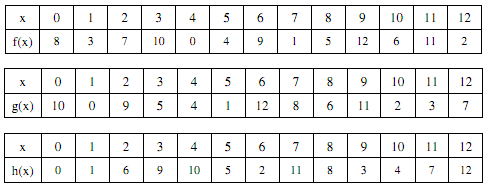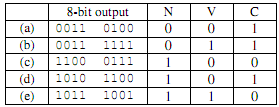Reference no: EM131605
Question 1
Consider the functions f, g and h, all defined on the set {0, 1, 2, 3, ..., 12}

(i) Write down the values of: g(h(f(8))) and h-1 (g -1(3)).
(ii) Construct a table of values (like those shown above) for f (g(x)).
(iii) Construct a table of values for g-1(f-1(x)).
(iv) Construct a table for h-1
(x), and draw its graph on the grid provided on the last page.
Question 2
Suppose there is a set of growers G = {a, b, c, d}, a set of retailers R = {e, f, g} and a set of customers C = {m, n, p, q, r}. There are two relations A and B on G × R and R × C, respectively, defined by:
aAe, aAf, bAg, cAf, dAe, and eBn, eBr, fBm, fBq, gBn, gBp
xAy means "grower x sold goods to retailer y", and
yA-1 x means "retailer y bought goods from grower x"
xBy means "retailer x sold goods to customer y", and
yB-1x means "customer y bought goods from retailer x"
(i) Find the matrices M(A) and M(B) that represent the relations A and B.
(ii) Find the matrices M(A)T and M(B)T that represent the relations A-1 and B-1
(iii) Consider the queries:
Which customers have received goods that came from the same grower(s) as those goods received by (a) customer n? (b) customer p?
Find the logical matrix products M(A) M(B) and then M(B)TM(A)T, and finally M(B)T M(A)T M(A) M(B), and hence answer the queries.
Question 3
(a) Consider the following table:

(i) Convert each of the decimal numbers in the first column to octal.
(ii) Convert the two octal numbers to binary.
(iii) Convert the two binary numbers to hexadecimal.
(iv) Add the two hexadecimal numbers.
(v) Convert the hexadecimal sum to binary, then to octal and then to decimal.
(b)
(i) Convert the decimal fraction 0.296875 to binary;
(ii) Convert the decimal fraction 0.453125 to binary;
(iii) Add the two binary fractions from (i) and (ii);
(iv) Convert the binary fraction from (iii) to decimal.
(c) Add the following, given that (i) is binary, (ii) is octal and (iii) is hexadecimal:

(d) Suppose that the following numbers are all hexadecimal. Carry out the additions with the appropriate "decimal adjustments" so as to obtain answers that are correct when interpreted as decimal.

Question 4
For each of the following, suppose that two 8-bit binary numbers have been added. In each case the 8-bit output is given and the values of the N, V and C flags. For each case give the correct answer as a decimal number:
(i) if the result is interpreted as the sum of unsigned integers;
(ii) if the result is interpreted as the sum of signed integers.
